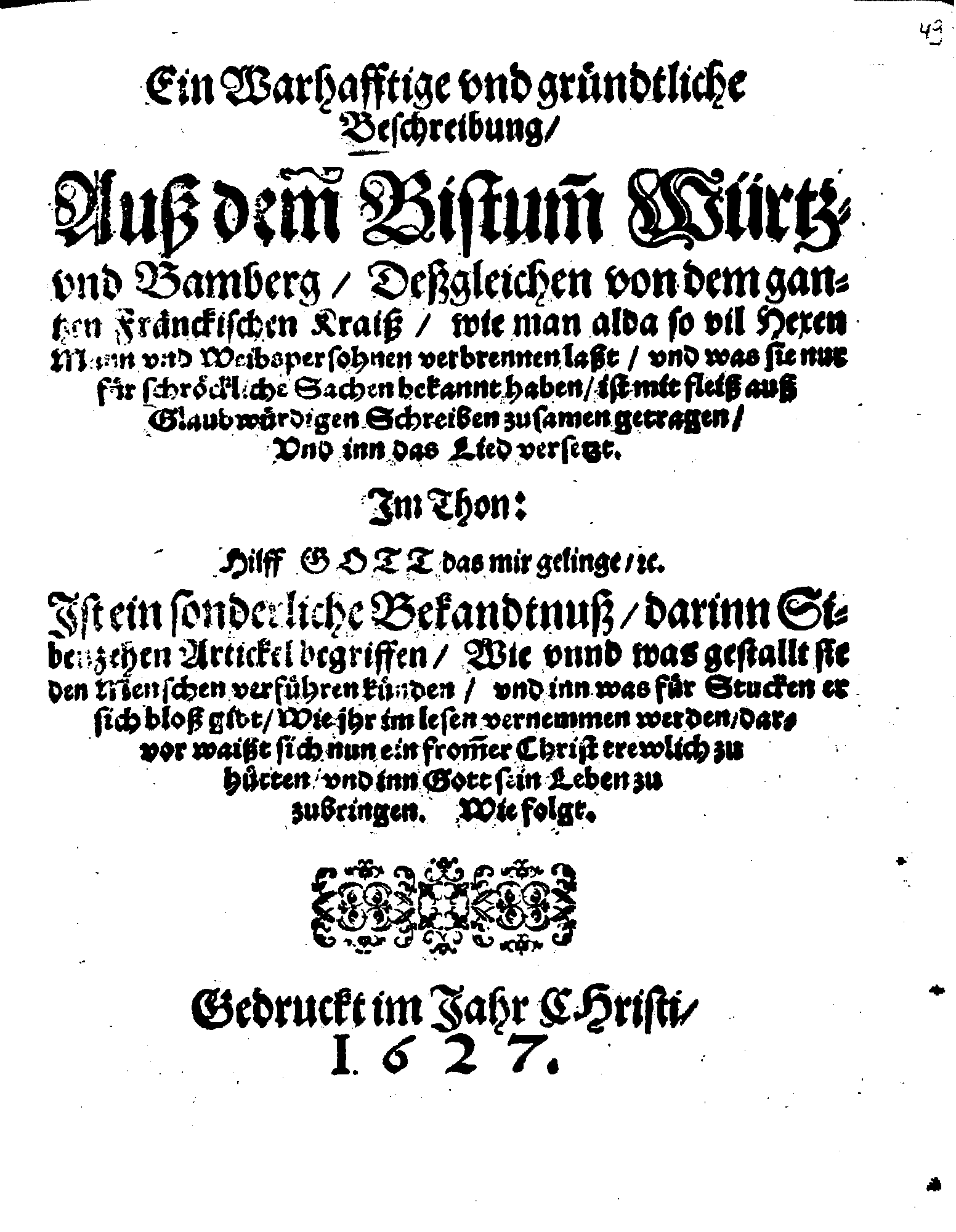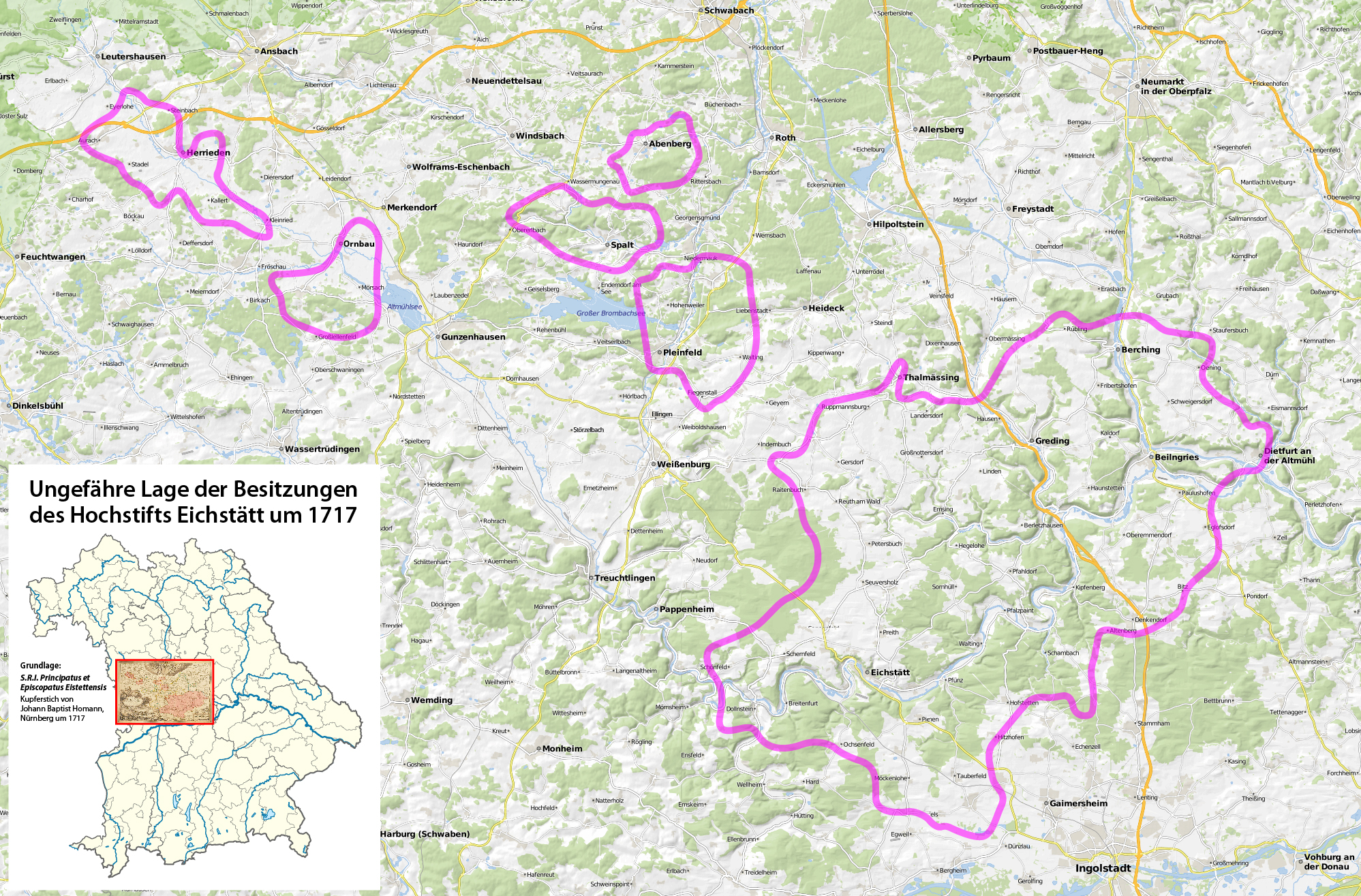|
Würzburg Witch Trials
The Würzburg witch trials of 1625–1631, which took place in the self-governing Catholic Prince-Bishopric of Würzburg in the Holy Roman Empire in present-day Germany, formed one of the biggest mass trials and mass executions ever seen in Europe, and one of the largest witch trials in history. The trials resulted in the execution of hundreds of people of all ages, sexes and classes, all of whom were burned at the stake, sometimes after having been beheaded, sometimes alive. One hundred fifty-seven men, women and children in the city of Würzburg are confirmed to have been executed; 219 are estimated to have been executed in the city proper, and an estimated 900 were executed or died in custody in the Prince-Bishopric. The witch trials took place during the ongoing religious Thirty Years War between Protestants and Catholics, in an area on the religious border between Catholic and Protestant territories, and were conducted by a Catholic Prince Bishop intent on introducing the C ... [...More Info...] [...Related Items...] OR: [Wikipedia] [Google] [Baidu] |
Mainz
Mainz () is the capital and largest city of Rhineland-Palatinate, Germany. Mainz is on the left bank of the Rhine, opposite to the place that the Main (river), Main joins the Rhine. Downstream of the confluence, the Rhine flows to the north-west, with Mainz on the left bank, and Wiesbaden, the capital of the neighbouring state Hesse, on the right bank. Mainz is an independent city with a population of 218,578 (as of 2019) and forms part of the Frankfurt Rhine-Main, Frankfurt Rhine-Main Metropolitan Region. Mainz was founded by the Roman Empire, Romans in the 1st century BC as a military fortress on the northernmost frontier of the empire and provincial capital of Germania Superior. Mainz became an important city in the 8th century AD as part of the Holy Roman Empire, capital of the Electorate of Mainz and seat of the Elector of Mainz, Archbishop-Elector of Mainz, the Primate (bishop), Primate of Germany. Mainz is famous as the birthplace of Johannes Gutenberg, the inventor of ... [...More Info...] [...Related Items...] OR: [Wikipedia] [Google] [Baidu] |
Alsace
Alsace (, ; ; Low Alemannic German/ gsw-FR, Elsàss ; german: Elsass ; la, Alsatia) is a cultural region and a territorial collectivity in eastern France, on the west bank of the upper Rhine next to Germany and Switzerland. In 2020, it had a population of 1,898,533. Alsatian culture is characterized by a blend of Germanic and French influences. Until 1871, Alsace included the area now known as the Territoire de Belfort, which formed its southernmost part. From 1982 to 2016, Alsace was the smallest administrative ''région'' in metropolitan France, consisting of the Bas-Rhin and Haut-Rhin departments. Territorial reform passed by the French Parliament in 2014 resulted in the merger of the Alsace administrative region with Champagne-Ardenne and Lorraine to form Grand Est. On 1 January 2021, the departments of Bas-Rhin and Haut-Rhin merged into the new European Collectivity of Alsace but remained part of the region Grand Est. Alsatian is an Alemannic dialect closely related ... [...More Info...] [...Related Items...] OR: [Wikipedia] [Google] [Baidu] |
Rhine
), Surselva, Graubünden, Switzerland , source1_coordinates= , source1_elevation = , source2 = Rein Posteriur/Hinterrhein , source2_location = Paradies Glacier, Graubünden, Switzerland , source2_coordinates= , source2_elevation = , source_confluence = Reichenau , source_confluence_location = Tamins, Graubünden, Switzerland , source_confluence_coordinates= , source_confluence_elevation = , mouth = North Sea , mouth_location = Netherlands , mouth_coordinates = , mouth_elevation = , progression = , river_system = , basin_size = , tributaries_left = , tributaries_right = , custom_label = , custom_data = , extra = The Rhine ; french: Rhin ; nl, Rijn ; wa, Rén ; li, Rien; rm, label= Sursilvan, Rein, rm, label= Sutsilvan and Surmiran, Ragn, rm, label=Rumantsch Grischun, Vallader and Puter, Rain; it, Reno ; gsw, Rhi(n), inclu ... [...More Info...] [...Related Items...] OR: [Wikipedia] [Google] [Baidu] |
Bonn
The federal city of Bonn ( lat, Bonna) is a city on the banks of the Rhine in the German state of North Rhine-Westphalia, with a population of over 300,000. About south-southeast of Cologne, Bonn is in the southernmost part of the Rhine-Ruhr region, Germany's largest metropolitan area, with over 11 million inhabitants. It is a university city and the birthplace of Ludwig van Beethoven. Founded in the 1st century BC as a Roman settlement in the province Germania Inferior, Bonn is one of Germany's oldest cities. It was the capital city of the Electorate of Cologne from 1597 to 1794, and residence of the Archbishops and Prince-electors of Cologne. From 1949 to 1990, Bonn was the capital of West Germany, and Germany's present constitution, the Basic Law, was declared in the city in 1949. The era when Bonn served as the capital of West Germany is referred to by historians as the Bonn Republic. From 1990 to 1999, Bonn served as the seat of government – but no longer capital – ... [...More Info...] [...Related Items...] OR: [Wikipedia] [Google] [Baidu] |
Cologne
Cologne ( ; german: Köln ; ksh, Kölle ) is the largest city of the German western States of Germany, state of North Rhine-Westphalia (NRW) and the List of cities in Germany by population, fourth-most populous city of Germany with 1.1 million inhabitants in the city proper and 3.6 million people in the Cologne Bonn Region, urban region. Centered on the left bank of the Rhine, left (west) bank of the Rhine, Cologne is about southeast of NRW's state capital Düsseldorf and northwest of Bonn, the former capital of West Germany. The city's medieval Catholic Cologne Cathedral (), the third-tallest church and tallest cathedral in the world, constructed to house the Shrine of the Three Kings, is a globally recognized landmark and one of the most visited sights and pilgrimage destinations in Europe. The cityscape is further shaped by the Twelve Romanesque churches of Cologne, and Cologne is famous for Eau de Cologne, that has been produced in the city since 1709, and "col ... [...More Info...] [...Related Items...] OR: [Wikipedia] [Google] [Baidu] |
Sélestat
Sélestat (; Alsatian: ''Schlettstàdt''; German: ''Schlettstadt'') is a commune in the Grand Est region of France. An administrative division (Subprefectures in France, sous-préfecture) of the Bas-Rhin Departments of France, department, the town lies on the Ill (France), Ill river, from the Rhine and the Germany, German border. Sélestat is located between the largest communes of Alsace, Strasbourg and Mulhouse. In 2019, Sélestat had a total population of 19,242, which makes it the eighth most populous town in Alsace. During the Middle Ages and the Renaissance it was the third largest city in the region, after Strasbourg and Colmar, and it is ranked the third commune in Alsace for cultural heritage. Sélestat was founded in the 8th century as a port on the Ill and it experienced a long period of prosperity thanks to the trade in wine and a thriving religious and cultural life. It gradually declined after the Protestant Reformation, Reformation and the French conquest in the 17 ... [...More Info...] [...Related Items...] OR: [Wikipedia] [Google] [Baidu] |
Koblenz
Koblenz (; Moselle Franconian language, Moselle Franconian: ''Kowelenz''), spelled Coblenz before 1926, is a German city on the banks of the Rhine and the Moselle, a multi-nation tributary. Koblenz was established as a Roman Empire, Roman military post by Nero Claudius Drusus, Drusus around 8 B.C. Its name originates from the Latin ', meaning "(at the) confluence". The actual confluence is today known as the "Deutsches Eck, German Corner", a symbol of the unification of Germany that features an Emperor William monuments, equestrian statue of Emperor William I. The city celebrated its 2000th anniversary in 1992. It ranks in population behind Mainz and Ludwigshafen am Rhein to be the third-largest city in Rhineland-Palatinate. Its usual-residents' population is 112,000 (as at 2015). Koblenz lies in a narrow flood plain between high hill ranges, some reaching mountainous height, and is served by an express rail and autobahn network. It is part of the populous Rhineland. History ... [...More Info...] [...Related Items...] OR: [Wikipedia] [Google] [Baidu] |
Neuburg An Der Donau
Neuburg an der Donau (Central Bavarian: ''Neiburg an da Donau'') is a town which is the capital of the Neuburg-Schrobenhausen district in the state of Bavaria in Germany. Divisions The municipality has 16 divisions: * Altmannstetten * Bergen, Neuburg * Bittenbrunn * Bruck * Feldkirchen * Gietlhausen * Hardt * Heinrichsheim * Herrenwörth * Hessellohe * Joshofen * Marienheim * Maxweiler * Laisacker * Sehensand * Zell History Neuburg has been inhabited since the Bronze Age with artifacts discovered on the hill where the modern palace is located. A Roman settlement was also located on the high hill overlooking the Danube, providing a part of the Limes, the border between the Empire and its Germanic enemies. The massive Neuburg Castle was built during the early Middle Ages by the Aiglolfings, at the site of the old Roman fortress. In 1527 the Wittelsbach Family re-designed the castle into a Renaissance palace, which is what we see today. Neuburg was part of an episcopal see. In ... [...More Info...] [...Related Items...] OR: [Wikipedia] [Google] [Baidu] |
Reichertshofen
Reichertshofen is a market town and municipality in the district of Pfaffenhofen in Bavaria Bavaria ( ; ), officially the Free State of Bavaria (german: Freistaat Bayern, link=no ), is a state in the south-east of Germany. With an area of , Bavaria is the largest German state by land area, comprising roughly a fifth of the total lan ... in Germany The composer Willi Vogl was born in the city (1965) References Pfaffenhofen (district) {{Pfaffenhofen-geo-stub ... [...More Info...] [...Related Items...] OR: [Wikipedia] [Google] [Baidu] |
Eichstätt Witch Trials
The Eichstätt witch trials was a series of witch trials that took place in the Prince-Bishopric of Eichstätt (German: Hochstift Eichstätt, Fürtsbistum Eichstätt), Bavaria, Germany, between 1532 and 1723. They resulted in the execution of at least 224 people (197 women and 27 men), and were among the biggest witch trials in Germany. The trials were mainly conducted under the approval of Prince Bishop Johann Christoph von Westerstetten between 1613 and 1630. The last known execution in Eichstätt was conducted in 1723. Persecution phases Early phase before 1562 The first known executions for witchcraft in Eichstätt were carried out in 1532 when two women were sentenced to death. The same happened to another woman in 1535. Margreth Auerhamerin was expelled from the bishopric in 1551 as she did not confess any witchcraft which she was accused of. First phase 1562–1590 The first larger persecution happened under the authority of Prince-Bishop Martin von Schaumberg ( ... [...More Info...] [...Related Items...] OR: [Wikipedia] [Google] [Baidu] |
Edict Of Restitution
The Edict of Restitution was proclaimed by Ferdinand II, Holy Roman Emperor in Vienna, on 6 March 1629, eleven years into the Thirty Years' War. Following Catholic military successes, Ferdinand hoped to restore control of land to that specified in the Peace of Augsburg (1555). That treaty's " Ecclesiastical Reservation" had prohibited further secularization of lands held by the Catholic church after 1555, disallowing any transfer of such lands to Protestant control. However, as the Holy Roman Empire descended into the Thirty Years' War, weak emperors had been unable to enforce this provision against Protestant encroachments. Background The Diet of Speyer (1526) introduced the principle of ''cuius regio, eius religio'': in essence, agreeing to disagree within the Holy Roman Empire. With that principle confirmed by the Peace of Augsburg, large-scale violence between Lutherans and Catholics in Germany was temporarily avoided. Some Protestant princes interpreted this principle ... [...More Info...] [...Related Items...] OR: [Wikipedia] [Google] [Baidu] |






